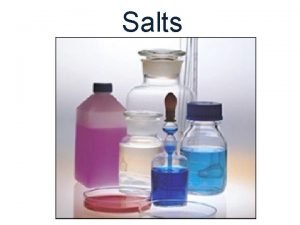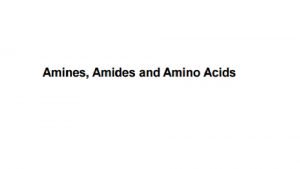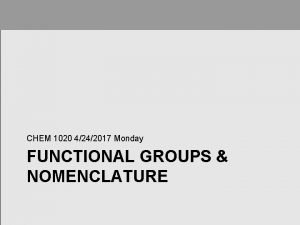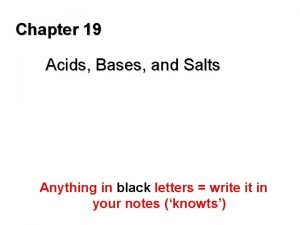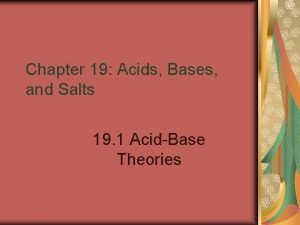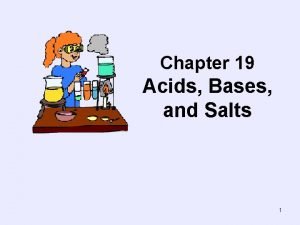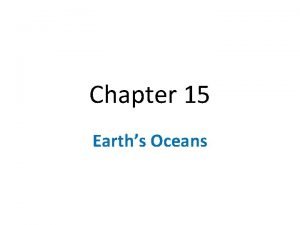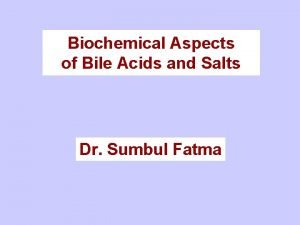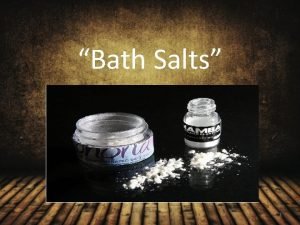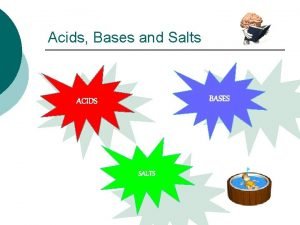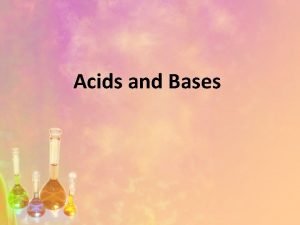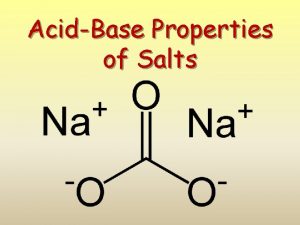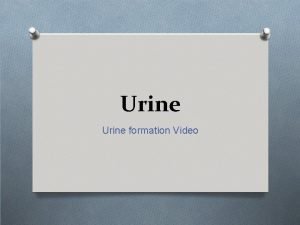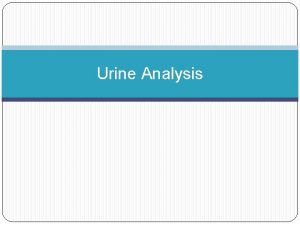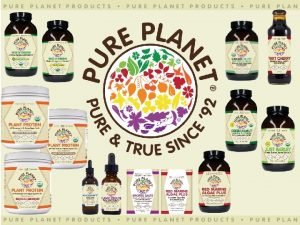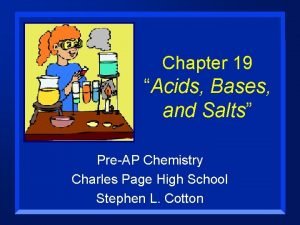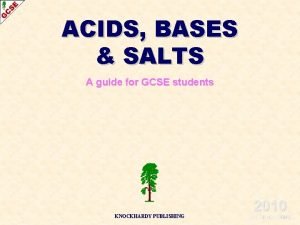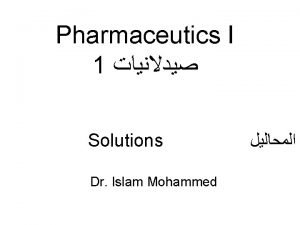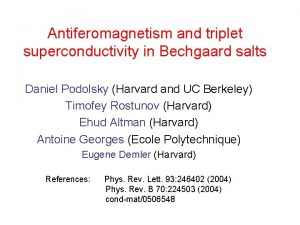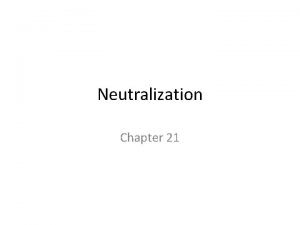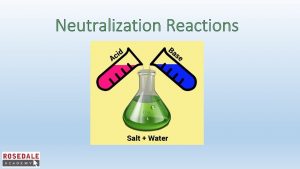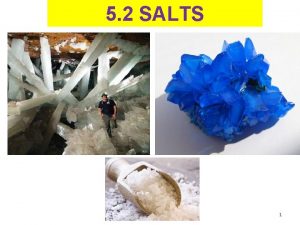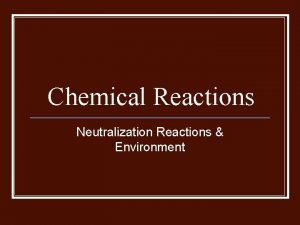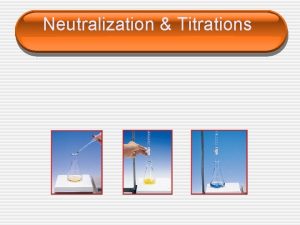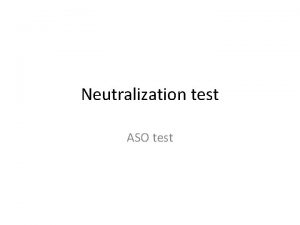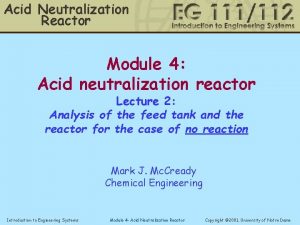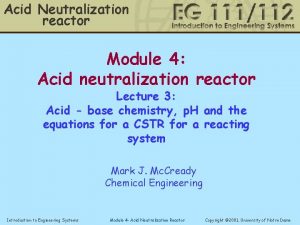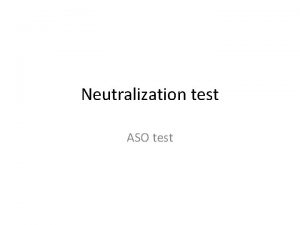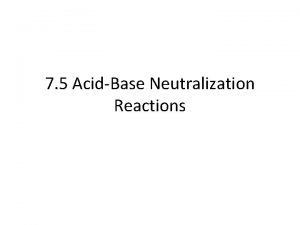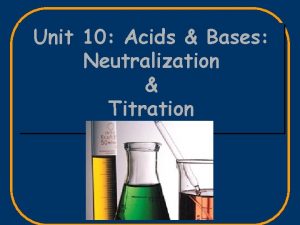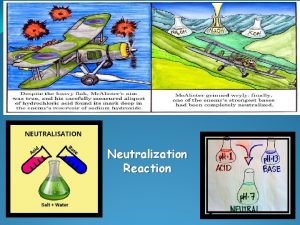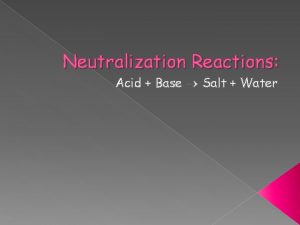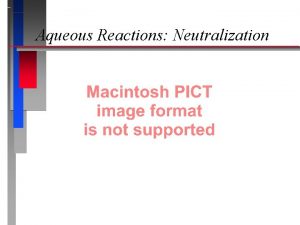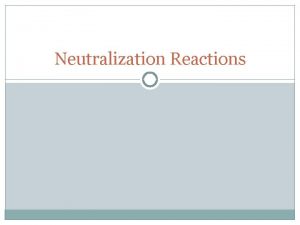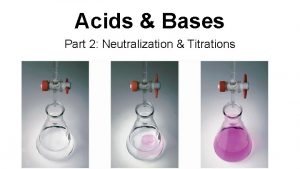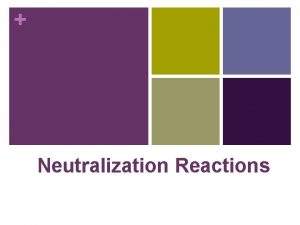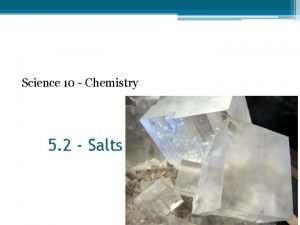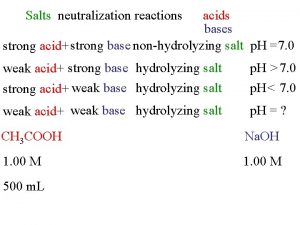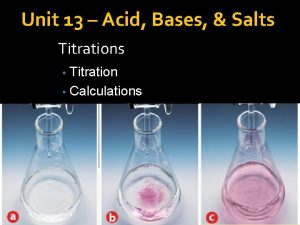Section Salts 3 Neutralization Neutralization is a chemical
























- Slides: 24

Section Salts 3 Neutralization • Neutralization is a chemical reaction between an acid and a base that takes place in a water solution. • For example, when HCI is neutralized by Na. HCO 3, hydronium ions from the acid combine with hydroxide ions from the base to produce sodium chloride, carbon dioxide, and neutral water.

Section Salts 3 Neutralization • A salt is a compound formed when the negative ions from an acid combine with the positive ions from a base.

Section 3 Salts Acid-Base Reactions • The following general equation represents acid-base reactions in water. • Another neutralization reaction occurs between HCI, an acid, and Ca(OH)2, a base producing water and the salt Ca. Cl 2.

Section Salts 3 Salts • Salt is essential for many animals large and small. • You need salt too, especially because you lose salt in perspiration.

Section Salts 3 Salts • Most salts are composed of a positive metal ion and an ion with a negative charge, such as Cl or CO 32. • Ammonium salts contain the ammonium ion, NH 4+, rather than a metal.

Section Salts 3 Titration • Sometimes you need to know the concentration of an acidic or basic solution; for example, to determine the purity of a commercial product. • This can be done using a process called titration (ti TRAY shun), in which a solution of known concentration is used to determine the concentration of another solution.

Section Salts 3 Titration • Titration involves a solution of known concentration, called the standard solution. • This is added slowly and carefully to a solution of unknown concentration to which an acid/base indicator has been added.

Section Salts 3 Titration • If the solution of unknown concentration is a base, a standard acid solution is used. • If the unknown is an acid, a standard base solution is used. Click box to play movie

Section 3 Salts The Endpoint Has a Color Change • To find the concentration of an acid solution, first, you would add a few drops of an indicator, such as phenolphthalein (fee nul THAY leen), to a carefully measured amount of the solution of unknown concentration. • Then, you would slowly and carefully add a base solution of known concentration to this acid-andindicator mixture.

Section 3 Salts The Endpoint Has a Color Change • Toward the end of the titration you must add base drop by drop until one last drop of the base turns the solution pink and the color persists. • The point at which the color persists is known as the end point, the point at which the acid is completely neutralized by the base.

Section 3 Salts The Endpoint Has a Color Change • Many natural substances are acid-base indicators. • The indicator litmus comes from a lichen a combination of a fungus and an algae or cyanobacterium. • Flowers that are indicators include hydrangeas, which produce blue blossoms when the p. H of the soil is acidic and pink blossoms when the soil is basic.

Section 3 Salts Soaps and Detergents • The next time you are in a supermarket, go to the aisle with soaps and detergents. You’ll see all kinds of products solid soaps, liquid soaps, and detergents for washing clothes and dishes.

Section 3 Salts Soaps and Detergents • Do they differ from one another? Yes, they do differ slightly in how they are made and in the ingredients included for color and aroma. • Still, all these products are classified into two types soaps and detergents.

Section Salts 3 Soaps • Soaps are salts. • They have a nonpolar organic chain of carbon atoms on one end and either a sodium or potassium salt of a carboxylic acid (kar bahk SIHL ihk), –COOH, group at the other end.

Section Salts 3 Soaps • To make an effective soap, the acid must contain 12 to 18 carbon atoms. • If it contains fewer than 12 atoms, it will not be able to mix well with and clean oily dirt.

Section Salts 3 Soaps • The long hydrocarbon part of a soap molecule mixes well with oily dirt while the ionic end attracts water molecules. • Dirt now linked with the soap rinses away as water flows over it.

Section 3 Salts Commercial Soaps • A simple soap can be made by reacting a long-chain fatty acid with sodium or potassium hydroxide. • One problem with all soaps, however, is that the sodium and potassium ions can be replaced by ions of calcium, magnesium, and iron found in some water known as hard water. Click box to play movie

Section 3 Salts Commercial Soaps • When this happens, the salts formed are insoluble. • They precipitate out of solution in the form of soap scum.

Section Salts 3 Detergents • Detergents are synthetic products that are made from petroleum molecules, instead of from natural fatty acids like their soap counterparts. • Similar to soaps, detergents have long hydrocarbon chains, but instead of a carboxylic acid group (–COOH) at the end, they may contain instead a sulfonic acid group.

Section Salts 3 Detergents • Some detergents contained phosphates, the use of which has been restricted or banned in many states, and these are no longer produced because they cause water pollution. • Certain sulfonic acid detergents also present problems in the form of excess foaming in water treatment plants and streams.

Section Check 3 Question 1 Neutralization takes place in a(n) _____ solution. A. B. C. D. acid base gaseous water

Section 3 Section Check Answer The answer is D. Neutralization is a chemical reaction between an acid and a base and takes place is a water solution.

Section 3 Section Check Question 2 What type of compound forms when negative ions from an acid combine with positive ions from a base? Answer A salt is a compound that forms when negative ions from an acid combine with positive ions from a base.

Section 3 Section Check Question 3 What is the general equation representing acid-base reactions in water? Answer The general equation is acid + base → salt + water. A specific example is:
 Section 2 reinforcement classifying chemical reactions
Section 2 reinforcement classifying chemical reactions Chemical reactions section 2 classifying chemical reactions
Chemical reactions section 2 classifying chemical reactions Chemical reactions section 1 chemical changes
Chemical reactions section 1 chemical changes Displacement reaction examples
Displacement reaction examples Acid base and salt
Acid base and salt Amine group
Amine group Naming esters
Naming esters Equations for acids and bases chem worksheet 19-1
Equations for acids and bases chem worksheet 19-1 Chapter 19 acids bases and salts
Chapter 19 acids bases and salts Chapter 19 acids bases and salts
Chapter 19 acids bases and salts Chapter 15 earth's oceans
Chapter 15 earth's oceans Functions of bile
Functions of bile White rush bath salts
White rush bath salts Acids bases and salts
Acids bases and salts Acid base properties of salts
Acid base properties of salts Acid base properties of salts
Acid base properties of salts Urine formation video
Urine formation video Fouchet's test principle
Fouchet's test principle Pure planet tart cherry concentrate
Pure planet tart cherry concentrate Bile salts in urine
Bile salts in urine Chapter 19 acids bases and salts
Chapter 19 acids bases and salts Soluble salts can be made by mixing acids and alkalis
Soluble salts can be made by mixing acids and alkalis Example of elixir in pharmacy
Example of elixir in pharmacy Antiferomagnetism
Antiferomagnetism Soluble and insoluble salts lab 15 answers
Soluble and insoluble salts lab 15 answers



